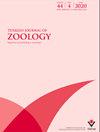New insights on the impact of earthworm extract on the growth of beneficial soil fungi: species-specific alteration of the nematophagous fungal growth and limitation of an entomopathogenic fungus
IF 1.3
4区 生物学
Q2 ZOOLOGY
引用次数: 0
Abstract
: Earthworms influence soil ecosystem functions such as decomposition and regulation of nutrient cycles by burrowing, feeding, or secreting their cutaneous excreta. Earthworms can also modulate soil biodiversity and their interactions. Recent research has revealed that earthworm feeding activity or excretions can alter the performance of entomopathogenic nematodes (EPNs) and entomopathogenic fungi (EPFs), known biological control agents. Still, the impact of earthworm cadavers on the growth and reproduction of other biological control agents such as nematophagous fungus (NFs) and EPFs has been poorly explored. We suggest that earthworm body tissue could be used as a food supply by certain fungal species. We hypothesize that fungi with a high adaptive capacity as pathobionts such as NF will use earthworm cadavers to a certain extent, while the growth and reproduction of fungi with limited or specific nutrition needs, such as EPFs, will be restricted. In this study, we evaluated two NF species: a nematode-trapping fungus Arthrobotrys musiformis Drechsler (Orbiliales: Orbiliaceae) and a nematode egg or cyst parasite Purpureocillium lilacinum (Thom) (Hypocreales: Ophiocordycipitaceae), and one EPF species: Beauveria bassiana (Balsamo). We exposed each fungus to two different Aporrectodea molleri extract media at six concentrations in agar medium (n = 3 per treatment) and liquid medium (n = 5): (i) earthworms devoid of intestinal contents (EDG) (C1...C6), and (ii) fresh earthworms (FE) (C1...C6). The use of FE and EDG was designed to discriminate the effect of earthworms’ intestinal content on fungal growth. These treatments were also compared to alternative conventional media potato dextrose agar (PDA) and brain heart infusion (BHI) as the positive controls. We evaluated the vegetative growth capacity daily for 18 days, registering the reproduction at the end of the experiment. We observed that EPF B. bassiana did not grow in FE and EDG solid medium but showed germination in their liquid media. However, both NF species could grow and reproduce in both media but following a species-specific pattern. In all cases, FE and EDG reduced fungal growth compared to PDA and BHI. Our results suggest that the use of earthworm as a resource in natural conditions might depend on the expected specialization, with EPF B. bassiana with the lowest use, NF A. musiformis moderately, and P. lilacinum widely used. The study illustrates the complexity of the soil organisms’ interactions and highlights the necessity to advance the understanding of the contribution of all the beneficial soil organisms in a comprehensive manner.蚯蚓提取物对有益土壤真菌生长影响的新见解:食线虫真菌生长的物种特异性变化和一种昆虫病原真菌的局限性
蚯蚓通过挖洞、取食或分泌表皮排泄物来影响土壤生态系统功能,如分解和调节养分循环。蚯蚓还可以调节土壤生物多样性及其相互作用。最近的研究表明,蚯蚓的摄食活动或排泄物可以改变昆虫病原线虫(EPNs)和昆虫病原真菌(EPFs)的性能,这是已知的生物防治剂。然而,蚯蚓尸体对其他生物防治剂如噬线虫真菌(nf)和epf的生长和繁殖的影响尚未得到充分探讨。我们认为蚯蚓的身体组织可以作为某些真菌种类的食物来源。我们推测,NF等具有高适应能力的真菌会在一定程度上利用蚯蚓尸体,而EPFs等营养需求有限或特定的真菌的生长和繁殖将受到限制。在这项研究中,我们评估了两个NF种:捕获线虫的真菌Arthrobotrys musiformis Drechsler (Orbiliales: Orbiliaceae)和线虫卵或囊肿寄生虫紫丁香紫孢(Purpureocillium lilacinum (Thom) (Hypocreales: Ophiocordycipitaceae),以及一个EPF种:白僵菌(Balsamo)。我们将每种真菌暴露在琼脂培养基(每次处理n = 3)和液体培养基(n = 5)中两种不同浓度的Aporrectodea molleri提取物培养基中:(i)缺乏肠道内容物(EDG) (C1…C6)和(ii)新鲜蚯蚓(FE) (C1…C6)。利用FE和EDG测定蚯蚓肠道内容物对真菌生长的影响。这些处理还与替代传统培养基马铃薯葡萄糖琼脂(PDA)和脑心输注(BHI)作为阳性对照进行了比较。连续18 d每天测定营养生长量,试验结束时记录繁殖情况。我们观察到球孢EPF在FE和EDG固体培养基中不生长,而在其液体培养基中萌发。然而,两种NF物种都可以在两种培养基中生长和繁殖,但遵循一种特定的模式。在所有情况下,与PDA和BHI相比,FE和EDG减少了真菌的生长。结果表明,在自然条件下,蚯蚓作为资源的利用可能取决于预期的专门化,其中球孢蚯蚓的利用率最低,蕈状蚯蚓的利用率中等,而淡紫色蚯蚓的利用率较高。该研究说明了土壤生物相互作用的复杂性,并强调了全面了解所有有益土壤生物的贡献的必要性。
本文章由计算机程序翻译,如有差异,请以英文原文为准。
求助全文
约1分钟内获得全文
求助全文
来源期刊

Turkish Journal of Zoology
ZOOLOGY-
CiteScore
2.30
自引率
10.00%
发文量
24
审稿时长
6-12 weeks
期刊介绍:
The Turkish Journal of Zoology is published electronically 6 times a year by the Scientific and Technological Research Council of Turkey (TÜBİTAK).
-Accepts English-language manuscripts in various fields of zoology including systematics, developmental biology, behaviour biology, animal models, molecular biology and molecular phylogeny, genomics, physiology (cell communication and signaling systems), biochemistry and immunohistochemistry, applied parasitology and pathology, nanobiotechnology, ecology, evolution, and paleontology of animal taxa.
-Contribution is open to researchers of all nationalities.
-Short communications are also welcome, such as reports of a preliminary nature or those including new records from specific localities or regions, and the editor reserves the right to decide that a paper be treated as a short communication.
-The papers that deal with purely checklists, new host and non-regional new locality records will not be consider for publication.
-Letters to the editor reflect the opinions of other researchers on the articles published in the journal. The editor may also invite review articles concerning recent developments in particular areas of interest.
 求助内容:
求助内容: 应助结果提醒方式:
应助结果提醒方式:


